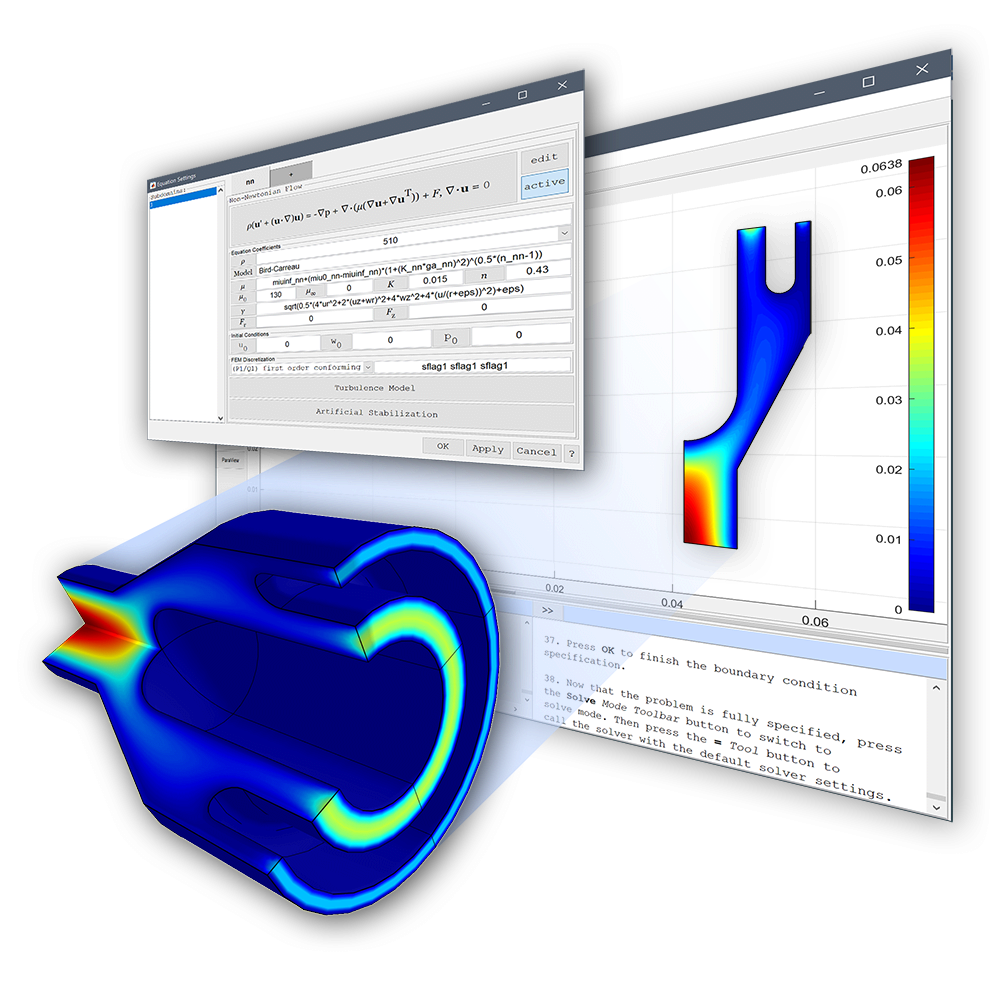The easy to use FEATool Multiphysics™ toolbox has now been updated to version 1.15. Major new features of this release include pre-defined physics modes dedicated to simulation of non-Newtonian flows, new and updated mesh generation options, and improved graphics performance for visualization of large 3D models.
Simulation of non-Newtonian Flows
FEATool 1.15 adds pre-defined equations and a new physics mode for non-Newtonian flows. This allows for easy modeling and simulation of applications with non-linear shear thinning or thickening flow behavior, such as in industrial polymer applications, and biological flows.
The non-Newtonian flow physics mode includes the pre-defined power law, Cross power law, and Bird-Carreau viscosity models. In addition users can also easily define their own shear rate dependent viscosity expressions with the simple FEATool equation syntax. Moreover, the non-Newtonian flow models has also been extended to fully support the external solvers OpenFOAM and FEniCS.
New Mesh Generation Functionality
FEATool now also includes built-in 3D mesh generators making it more convenient for users. This update removes dependence on installation of external meshing tools, which allows users to get started with 3D modeling right away. The new mesh generation options allow for better and more robust meshing, handing both larger CAD (STEP, IGES) and faceted (STL, OBJ) geometry types.
Support for the external and optional Gmsh and Triangle mesh generators is still included, so that users can try and choose between many mesh generation algorithms to see which works best. Moreover, a new directional mesh scaling option has also been introduced allowing for anisotropic and adaptive meshing in different directions, which both help to improve accuracy and reduce simulation times for applicable models.

In addition, a new menu option in the GUI is available to manually renumber, reassign, and group boundaries. This is for example be useful for imported faceted (STL/OBJ) geometries where boundary information is not present in the geometry data. Moreover, a view boundaries/subdomains geometry menu option is now also available, which allows one to see the boundary numbering for the mesh generation process. This enables users to easily assign different mesh sizes do different boundaries and subdomains.
Improved Visualization Performance
The 3D graphics functionality of FEATool has also been improved to handle larger models with many objects and faces. It should now be possible to comfortably solve and render significantly larger models than before. Moreover, 3D plots now fill up the whole viewport and feature CAD style orbit, pan, and zoom controls, making it easier for users to visualize and inspect models and solution data.

Solver Hooks
A new solve mode menu option has also been added to the GUI to enable definition of solver hooks. Solver hooks are user defined functions which can be used to access and directly modify model data during the solution process. This powerful feature enables completely custom and advanced solution techniques to be implemented, such as
- Defining custom monitoring of variables during the solution process
- Introducing couplings between boundaries and domains
- Implementing special constraints and limiters on solution components
- Adding non-standard boundary conditions (such as enforcing periodicity or flux directions)
The solver hook functionality, combined with the user defined material and coefficient functions, and open linear solver framework, allow for complete customization of physics simulation models and implementation of advanced custom solvers.
New Simulation Tutorials
The following new simulation tutorials have been published
- Non-Newtonian polymer flow in an extrusion die
- 3D solid-thermal stress validation example
- Multiphysics simulation of electro-osmotic flow in a T-junction
- Heated pipe with cooling fins validation example
Many more simulation examples are available in the tutorial section of the User’s Guide, and also as video tutorials on the FEATool Multiphysics YouTube channel. Moreover, MATLAB m-script code examples have also been published illustrating how to use the CLI command line interface to do more advanced postprocessing.
A detailed list of the new and updated features can be found in the FEATool Multiphysics Changelog.